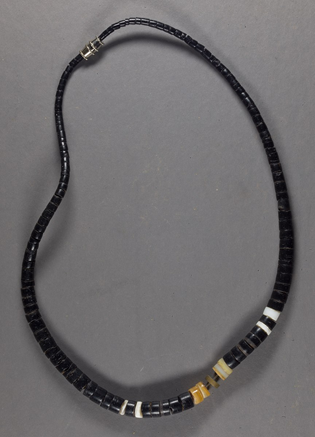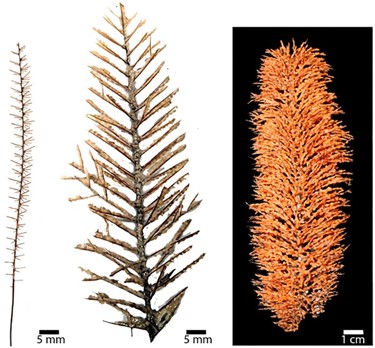Black corals are a group of largely deep-sea corals whose jet-black skeletons are highly prized for jewelry. But did you know that black corals are also among the longest-lived creatures on earth? Some individuals can live more than 4,000 years!
Black corals may be popular for making beautiful necklaces and rings, but please don’t rush to buy any—at least not before checking if the corals were sustainably harvested. Black corals are listed under CITES Appendix II, which means that although they are not currently considered endangered, they will likely become so unless efforts are made to protect them. CITES is an international agreement to protect species from illegal trafficking, and safeguards corals from excessive harvesting for jewelry.


A living colony of the black coral Leiopathes with orange polyps, or feeding mouths (left; photo credit: Dr. Scott France), and a black coral necklace from the Philippines (right; photo credit: Hannes Grobe).
Black corals provide more than jewelry, as they are instrumental to understanding ocean ecosystems. Opportunities to study these creatures are rare because they are difficult to collect, due to both CITES restrictions and how deep they live on the ocean floor—75 percent of species live deeper than 50 meters (deepest: 8,600 meters!). Because it can be so hard to access these organisms, OGL is lucky to have many black coral species in its collections, with samples available to scientists for research.
Dr. Mercer R. Brugler is one of those researchers. In a study published at the beginning of this year, Brugler and co-authors, including OGL researchers and 13 undergraduates (12 of whom were from the University of South Carolina Beaufort), used DNA samples from OGL’s collection and elsewhere to analyze the mitochondrial genomes of three different genera of black coral from the North Pacific Ocean. What they found was surprising: Despite looking very different, these three genera had nearly identical mitochondrial genomes at the molecular level—99.82 percent! This hints at a complex evolutionary history for these groups.

Genetically similar corals can look very different from each other! Parantipathes sp. (left), Lillipathes sp. (center), and Dendrobathypathes sp. (right) are three distinct-looking corals that have similar mitochondrial genomes (photo credit: Bledsoe-Becerra et al. 2022).
Not only are researchers learning new things about coral diversity, they are also describing new species! In 2021, Brugler and co-authors, again including OGL researchers, described two new genera and two new species of black corals. Discovering new animal species—yes, corals are animals!—doesn’t happen too often, so this is quite the occasion!
Understanding the diversity of black corals helps scientists better understand the range of life in the ocean and the best ways to protect these marine organisms. Climate change is impacting ocean environments by increasing the temperature, salinity, and acidity of the seawater. Corals tend to be very sensitive to the environment they live in, so the more we know about them, the more we will be able to protect and preserve them for generations to come.
Interested in helping researchers better understand black corals and their amazing genomes? Support OGL here.
